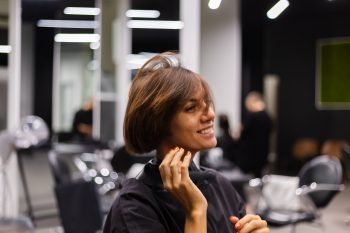We’ve all had that moment in the salon chair — the hopeful glance at the mirror, the reference photo pulled from Pinterest, and the quiet panic when it doesn’t turn out quite right. The truth is, a flattering haircut isn’t just about following trends or asking for what your friend got. It’s about finding a shape that works with your features.
Understanding your face shape can make all the difference between a haircut that feels “fine” and one that really brings out your best. It’s not about rules or rigid categories — just smart tweaks that enhance what’s already there.
We spoke to stylists to find out how to choose the most flattering cut for your face shape — and what to avoid.
ALSO READ: How to achieve gorgeous heatless curls
First, how do I know my face shape?
Take a look in the mirror with your hair pulled back. Notice the width of your forehead, cheekbones and jawline, and the length of your face from hairline to chin. Most people fall loosely into one of these categories: round, oval, square, heart, or long. No face is a perfect shape, and most are a mix — but these guidelines are a great starting point.
Now let’s get into it…

Freepik
Round face
You’re soft and symmetrical, with similar width and height and no sharp angles.
What works:
Go for styles that add length and definition. Long layers, angled lobs (long bobs), and side-swept fringes help elongate the face and bring balance. Layers around the jawline can contour without cutting things off too sharply.
Stylist tip: Movement is key. Avoid boxy shapes — instead, use soft layers to gently lengthen the face.
What to avoid:
Blunt chin-length bobs or heavy fringes that sit straight across — they can make the face appear rounder.
Oval face
Your forehead is slightly wider than your chin, with balanced features and soft curves.
What works:
Almost everything! Oval faces are versatile, which means you can play with length, fringe, and texture. A sleek bob, shaggy layers, a pixie with side-swept bangs, or beachy waves — it’s up to you.
Stylist tip: Focus on what you want to highlight — cheekbones, eyes, jaw — and use layers to guide the attention.
What to avoid:
One-length, ultra-long hair with no movement. It can pull the face downward and flatten your features.
Square face
You’ve got a strong jaw, broad forehead, and bold bone structure.
What works:
Soften the edges with movement and curve. Shoulder-length waves, feathered ends, and side-swept bangs help soften the jawline and create balance. Long layers that start below the cheekbone work beautifully.
Stylist tip: Soft, swoopy layers create contrast against a strong bone structure without hiding it.
What to avoid:
Super blunt cuts (unless you’re going for drama) or poker-straight styles that can overemphasise angularity.
Heart-shaped face
Your forehead is wider than your jaw, and your chin is more tapered.
What works:
Aim to balance the top and bottom halves of the face. Chin-length bobs, shoulder-length waves, and side-swept fringes can soften a pointed chin and draw attention to the eyes and cheekbones.
Stylist tip: Avoid too much volume on top — you want to fill out the jaw area instead, especially with curls or texture.
What to avoid:
Blunt fringes or high-volume crowns, which can make the upper face look even wider.
Long face
Your face is noticeably longer than it is wide, with similar width from forehead to jaw.
What works:
Add width and movement to balance length. Fringes are ideal — curtain bangs, blunt bangs or even a fringe that hits just below the brow. Soft waves, bobs, and mid-length cuts create the illusion of more width.
Stylist tip: Play with shape. Fringes break up the length beautifully, and volume at the sides helps too.
What to avoid:
Extra-long, straight hair with no layers — it can drag the face down even more.
Before you hit the salon…
Knowing your face shape is a great starting point, but it’s not a rulebook. The best haircut is one that makes you feel like yourself, just a little more polished. Bring inspiration to your stylist, but be open to their input — they’ll help tweak it for your hair texture, lifestyle and face structure.
Because a great cut doesn’t just flatter your features. It lifts your confidence, simplifies your routine, and sometimes, reminds you that you’ve still got it.
ALSO SEE:
Thinking of cutting a fringe? Here’s what to really consider
Feature Image: Freepik

